
|
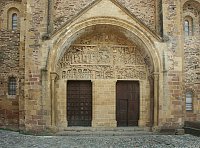
|
The western facadeThe tympanum is about 6.7 meters wide and 3.6 meters high. It is about 3.6 meters above the ground so it is quite readable from the ground level--in spite of a large number of figures. |
| |
|
The Last JudgmentOn the western facade of the abbey church a deep semi-circular arch contains the tympanum of the Last Judgment. This subject, as well as the Apocalypse, was popular in Romanesque churches in south and southwest France. The tympanum is remarkable for its state of preservation, including some of the original polychromy (though the painted areas are faded), for its large number of figures (more than a hundred if one counts angels and demons), and for the originality of its quasi-realistic depiction of the torments in Hell. It is arranged in three registers: the top with four angels in a radial pattern; the middle with Christ in the center (not as much a focal point as he is in some tympana) and saved on this right and damned on the left; and a bottom row also divided between Heaven and Hell. Gables and banners are inscribed with biblical and moral passages for those who could read--an unusual feature in church facades. |

|
| |
|
The outer border of the arch: the "observer"This figure, with nose and eyes visible as he peers from behind the phylactery that he holds, is depicted fourteen times on the arch. Commentators are baffled by this curious figure (although tourists find cast reproductions of him in souvenir shops quite appealing). |
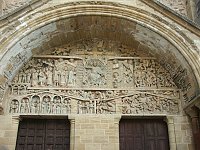
|
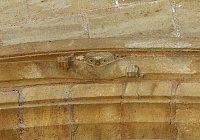
|
| |
|
The top registerThis row contains four angels--in the center two bearing the cross who hold the spear (LANCEA in the inscription)and a nail (CLAVI) and two in the clouds (indicated by ripples and scallops) who blow horns. Above the cross are the sun (SOL) and the Moon (LUNA) identified by the inscriptions and depicted as persons. One interpretation of their symbolic significance is that these heavenly bodies represent time, which is redeemed by Christ. See Matthew 24: 29-30: "Immediately after the tribulation of those days shall the sun be darkened, and the moon shall not give her light, and the stars shall fall from heaven, and the powers of the heavens shall be shaken: And then shall appear the sign of the Son of man in heaven: and then shall all the tribes of the earth mourn, and they shall see the Son of man coming in the clouds of heaven with power and great glory." The cross itself bears these words that can still be read: OC SIGNVM CRVCIS ERIT IN CELO CVM. Marilyn Stokstad translates this and the illegible part as: "The sign of the cross will appear in the heavens when the Lord comes to judge humanity" (227). |
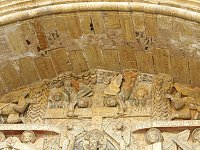 |
 |
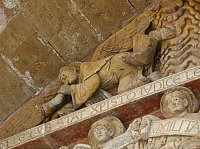
|
| |
|

|
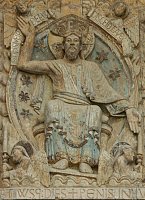
|
Christ enthroned in majestyAlthough the figure of Christ is set apart by the characteristic mandorla, his size is restricted by the height of the central register. Here, instead of the Evangelists symbols around him, there are four angels, the bottom two holding tall candlesticks. He is also surrounded by stars and points to one with his right hand. |
| |
|
The middle of the bottom registerHere (left and center images) there are two doors, one arched one as the entrance to Heaven, and the other more blocky with strong metal bracings. On the left (Christ's right) the Saved are being led to Heaven while on the right (Christ's left or "sinister" side) demons violently push the Damned into the mouth of Hell. The scene above (right image) is the traditional weighing of the souls scene, although here instead of tiny baby souls, the soul is represented by a squash or pumpkin. The devil appears to be cheating by pushing down the scale with his finger. The angel seems to be protecting another soul under its outstretched wing. |
|
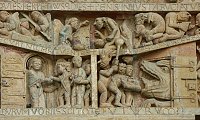
|
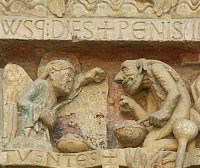
|


 Go to Sainte Foy Index.
Go to Sainte Foy Index. Click here to return to index of art historical sites.
Click here to return to index of art historical sites.
 Click here to return to index of artists and architects.
Click here to return to index of artists and architects.
 Click here to return to chronological index.
Click here to return to chronological index.
 Click here to see the home page of Bluffton University.
Click here to see the home page of Bluffton University.

